Holden HQ
| Holden HQ | |
|---|---|
 Holden Kingswood sedan | |
| Overview | |
| Manufacturer | Holden (General Motors) |
| Also called |
|
| Production | July 1971 – October 1974 |
| Assembly | Elizabeth, South Australia Dandenong, Victoria, Australia Pagewood, New South Wales, Australia Trentham, New Zealand |
| Body and chassis | |
| Body style | 4-door sedan 5-door wagon 2-door coupé 2-door coupé utility 2-door panel van 2-door cab chassis |
| Layout | FR layout |
| Related | Statesman HQ |
| Powertrain | |
| Engine | 173 cu in (2.8 L) I6 202 cu in (3.3 L) I6 253 cu in (4.1 L) V8 308 cu in (5.0 L) V8 350 cu in (5.7 L) V8 |
| Transmission | 3-speed manual 4-speed manual 3-speed automatic |
| Dimensions | |
| Wheelbase | 111 in (2,800 mm) 114 in (2,900 mm) (wagon) |
| Length | 187.5 in (4,760 mm) 190 in (4,800 mm) (wagon) |
| Width | 74.0 in (1,880 mm) 73.9 in (1,880 mm) (wagon) |
| Height | 54.0 in (1,370 mm) 54.8 in (1,390 mm) (wagons) 53.1 in (1,350 mm) (Monaro) |
| Curb weight | 2,950 lb (1,340 kg) (Kingswood sedan) |
| Chronology | |
| Predecessor | Holden HG |
| Successor | Holden HJ |
The Holden HQ series is a range of automobiles that was produced by Holden in Australia from 1971 to 1974. The HQ was released on 15 July 1971, replacing the Holden HG series.[1] It was the first ground up redesign of the Holden line since its original release in 1948,[2] and included an all-new body, chassis, and suspension.[1] The HQ was later developed into a series of successor models, finally ending production when the WB series was discontinued in 1984.
Model range[]
The mainstream HQ passenger car range consisted of four-door sedan and five-door station wagon models in three trim levels.[1]
- Holden Belmont sedan
- Holden Kingswood sedan
- Holden Premier sedan
- Holden Belmont station wagon
- Holden Kingswood station wagon
- Holden Premier station wagon
The long wheelbase luxury model, "Statesman by GMH" consisted of one body style (four-door sedan) and was available in two trim levels.
- Statesman
- Statesman Deville
A Holden SS sedan was released in August 1972.[2] Although marketed as a separate model in reality it was a Belmont V8 sedan fitted with the XV2 option package.[3][4]
The Monaro range initially consisted only of two-door coupes.[5]
- Holden Monaro
- Holden Monaro GTS
- Holden Monaro GTS 350
- Holden Monaro LS
Two four-door sedan variants of the Monaro GTS were released in March 1973[2] and similarly to the SS the new sports sedans were a special vehicle package optioned on a lesser model, in this case on a V8 Kingswood sedan. Option XV4 was the HQ GTS sedan. Option XW8 was the HQ GTS350 sedan.
The commercial vehicle range included coupe utility, panel van and cab chassis truck models.
- Holden Belmont utility
- Holden Kingswood utility
- Holden Belmont panel van
- Holden One Tonner
The One Tonner, which was new for the HQ series, was a cab chassis truck.[2] A Sandman option, which was offered on utility and panel van models from January 1974,[6] included various "sports" items from the Monaro GTS.[4]
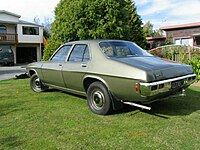
Holden Kingswood sedan
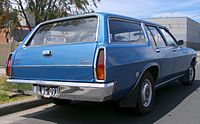
Holden Kingswood wagon

Holden Belmont sedan
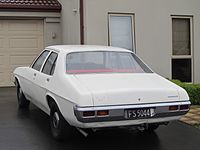
Holden Belmont sedan

Holden Belmont wagon
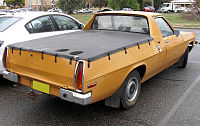
Holden Belmont utility

Holden Premier sedan
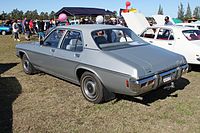
Holden Premier sedan

Holden Premier wagon (with non-standard wheels)

Holden Belmont Sandman panel van

Holden Belmont Sandman panel van

Holden Monaro
Holden Monaro LS
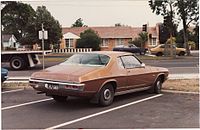
Holden Monaro LS
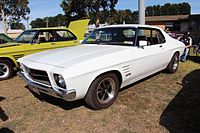
Holden Monaro GTS coupe

Holden Monaro GTS sedan
Engines[]
The two inline six cylinder engines from the HG range were carried over to the HQ, but were enlarged[2] to 173 cu in (2.8 L) and 202 cu in (3.3 L).[7] The 253 cu in (4.1 L) - marketed later as 4.2 liters, 308 cu in (5.0 L) and 350 cu in (5.7 L) V8's were also carried over.[7]
| Engine | Displacement | Compression | Power | Torque | Transmission | ||
|---|---|---|---|---|---|---|---|
| bhp | kW | ft·lb | N·m | ||||
| 2.83 L Red I6 | 173 cu in | Low | 112 | 84 | 160 | 220 | |
| High | 118 | 88 | 168 | 228 | |||
| 3.3 L Red I6 | 202 cu in | Low | 129 | 96 | 190 | 260 | |
| High | 135 | 101 | 194 | 263 | |||
| 4.2 L Holden V8 | 253 cu in | Low | 174 | 130 | 247 | 335 | |
| High | 185 | 138 | 262 | 355 | |||
| 5.0 L Holden V8 | 308 cu in | 240 | 180 | 315 | 427 | ||
| 5.7 L Chevrolet V8 | 350 cu in | 275 | 205 | 360 | 490 | ||
Production[]
Production of the HQ range totalled 485,650 vehicles[6] prior to its replacement by the Holden HJ series in October 1974.[8] Holden HQ series cars were produced at GMH plants in Adelaide (Elizabeth, South Australia), Melbourne (Dandenong, Victoria), Sydney (Pagewood, New South Wales) and in Brisbane (Acacia Ridge, Queensland).
Engines, transmissions, and final drive assemblies were produced at the engine casting plant at Fishermens Bend in Melbourne, although 350 cu in (5.7 L) engines and its drivetrain components were fully imported from the United States.
Many local automotive component businesses in all these states across Australia supplied the main plants with many other parts, such as wiper arms, glass, carpets, electrical systems, fasteners, and the like.
HQ production in New Zealand was at GMHNZ in Wellington, New Zealand using some NZ production components and ran until 1975 to use up HQ parts that weren't used on the following Holden HJ series.
South Africa[]
For the South African market, the Holden HQ sedan was marketed as the Chevrolet Kommando, and the HQ utility as the Chevrolet El Camino.[9] The Kommando received only the Chevrolet 4.1-litre six while the Constantia was also offered with the Holden 5.0-litre V8 coupled to an automatic transmission. The El Camino received both of these options as well as a new (to South Africa) 3.3-litre six, only in conjunction with a manual transmission.[10] The HQ One Tonner was sold as the Chevrolet El Toro.
Motorsport[]
With the introduction of the HQ model, Holden's factory supported production-car racing efforts shifted from the V8 Monaro to the smaller six-cylinder LC Torana. A few Monaro and V8 engined Kingswood cars were built for racing, most notably Malcolm Ramsey's V8 Kingswood. These HQs were never as successful as earlier model Monaros had been or the larger-budget Torana teams or the Ford Falcons and Mustangs they raced against.

From the late 1980s, the Holden HQ was used in Australia as the basis of a one-make motor racing category with an emphasis on cost. The category began in Tasmania but very quickly expanded to every state and New Zealand to become the entry-level motor racing category nationwide. The cars are built to comply with CAMS Group 3H Technical Regulations.[11] The series is utilises the 202 ci/3300 cc size six-cylinder engine, the largest six-cylinder engine sold in the car, and is limited to four-door sedan bodied cars.
The HQ motor racing category also had an effect on spare parts in wrecking yards around Australia, with parts and body panels becoming scarce as many of the teams would 'raid' the yards for cheap spares. This led to a shortage of spares for the HQ model for anyone who owned a road-going version.
Statesman HQ[]

The Statesman HQ range of long wheelbase luxury sedans, based on the Holden HQ series,[12] was also released in July 1971.[13] The Statesman models replaced the Holden Brougham from the HG range[13] however they were marketed as Statesmans rather than as Holdens.[14] The Statesman HQ was offered in two models, the base "Statesman Custom" and the premium "Statesman de Ville".[14]
References[]
- ^ a b c Darwin, Norm (2002), 100 Years of GM in Australia, Ballarat, Victoria: H@ND Publishing, p. 260, ISBN 9780646414768
- ^ a b c d e Davis, Tony (1987), Aussie Cars, p. 120
- ^ Holden SS V8 sales brochure, July 1972
- ^ a b Darwin, p. 260
- ^ Darwin, p. 258
- ^ a b Holden HQ Technical Specifications Retrieved from www.uniquecarsandparts.com.au on 24 February 2010
- ^ a b Holden HQ sales brochure, January 1972
- ^ Davis, p. 156
- ^ Holden abroad, Restored Cars No. 220, Sep-Oct 2013, pp. 45-47
- ^ Wright, Cedric, ed. (November 1972). "Chevrolet (HQ) Camino". CAR. Vol. 16, no. 10. Cape Town, South Africa: Ramsay, Son & Parker (Pty) Ltd. p. 9.
- ^ "How to get involved in HQ Racing". HQ Racing Australia. Retrieved 2 June 2010.[permanent dead link]
- ^ Davis, p. 121
- ^ a b Darwin, p. 259
- ^ a b Statesman (HQ) sales brochure, BD101, issued July 1971
- Cars of Australia
- Holden vehicles by series
- Cars introduced in 1971
- 1970s cars















